- Регистрация
- 15 Февраль 2018
- Сообщения
- 15 619
- Лучшие ответы
- 0
- Реакции
- 0
- Баллы
- 1 295
Offline
The Nintendo Switch and Steam Deck might have opened the floodgates for modern gaming handhelds, but once I got my hands on my first Android retro gaming handheld, I was in love. The combination of retro emulators and the versatility of Android makes these devices incredible for everything from reliving the classics to playing your favorite Windows or Switch games on the go. I’ve tested dozens of these handhelds at this point, and while many of them may look similar, there’s a lot to consider.
Everything from the controls and screen to the chipset and proprietary software can make or break a gaming handheld. With that in mind, here are the Android gaming handhelds I would recommend for each use case.
AYN Odin 2 Portal: The best Android gaming handheld overall

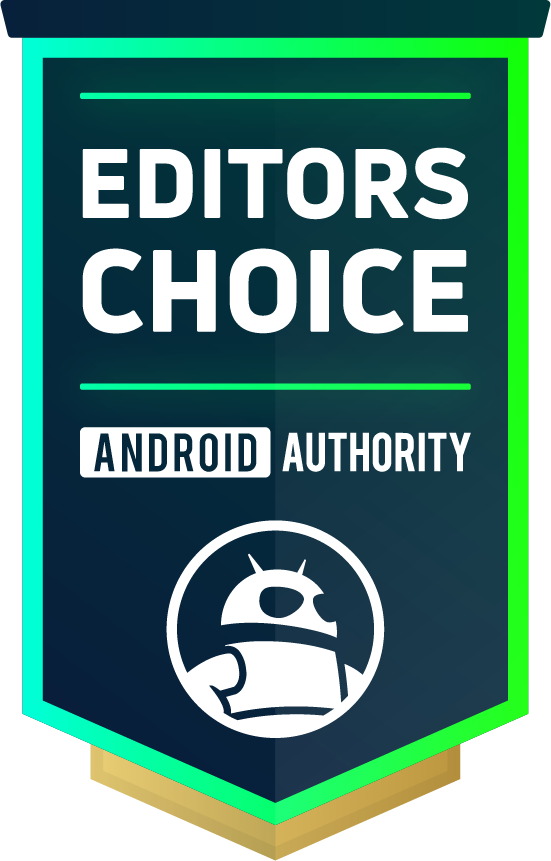
AYN Odin 2 Portal
Incredible display • Superb performance • Lightweight
MSRP: $329.00
The ultimate Android gaming handheld.
The Odin 2 Portal has a massive OLED screen and enough power to make the most of it.
Positives
Cons
For most people, the AYN Odin 2 Portal is the handheld to beat. Sure, it was released back in 2023, but the Snapdragon 8 Gen 2 is still an absolute powerhouse for emulation, and the 7-inch 120Hz AMOLED panel is still one of the best on the market.
No matter what you’re looking to play, the Odin 2 Portal can handle it with ease. Obviously that includes retro consoles, which look even better than the originals thanks to upscaling, shaders, and widescreen hacks. However, it can also handle the latest and greatest, including Nintendo Switch, PS3, and Windows emulation. The main limits there are software, not hardware.
That said, it is very large, and I wasn’t a fan of the ergonomics. I’d recommend picking up a simple grip to make it comfortable for longer gaming sessions, which the 8,000mAh battery is more than capable of powering through.
The Odin 2 Portal has a beautiful screen and enough power for demanding emulation.
I also have to mention that the Odin 3 is just around the corner, and it’s poised to revolutionize the Android gaming handheld space with a Snapdragon 8 Elite SoC. This is a massive leap forward in performance, but it will be at least six months to a year before driver support catches up. The Snapdragon 8 Gen 2 has some of the best driver support after years of Turnip driver improvements. You won’t see it on any spec sheets, but I cannot overstate just how important this is for emulation performance.

Nick Fernandez / Android Authority
Read more
Retroid Pocket 5/Flip 2: The best value Android gaming handheld
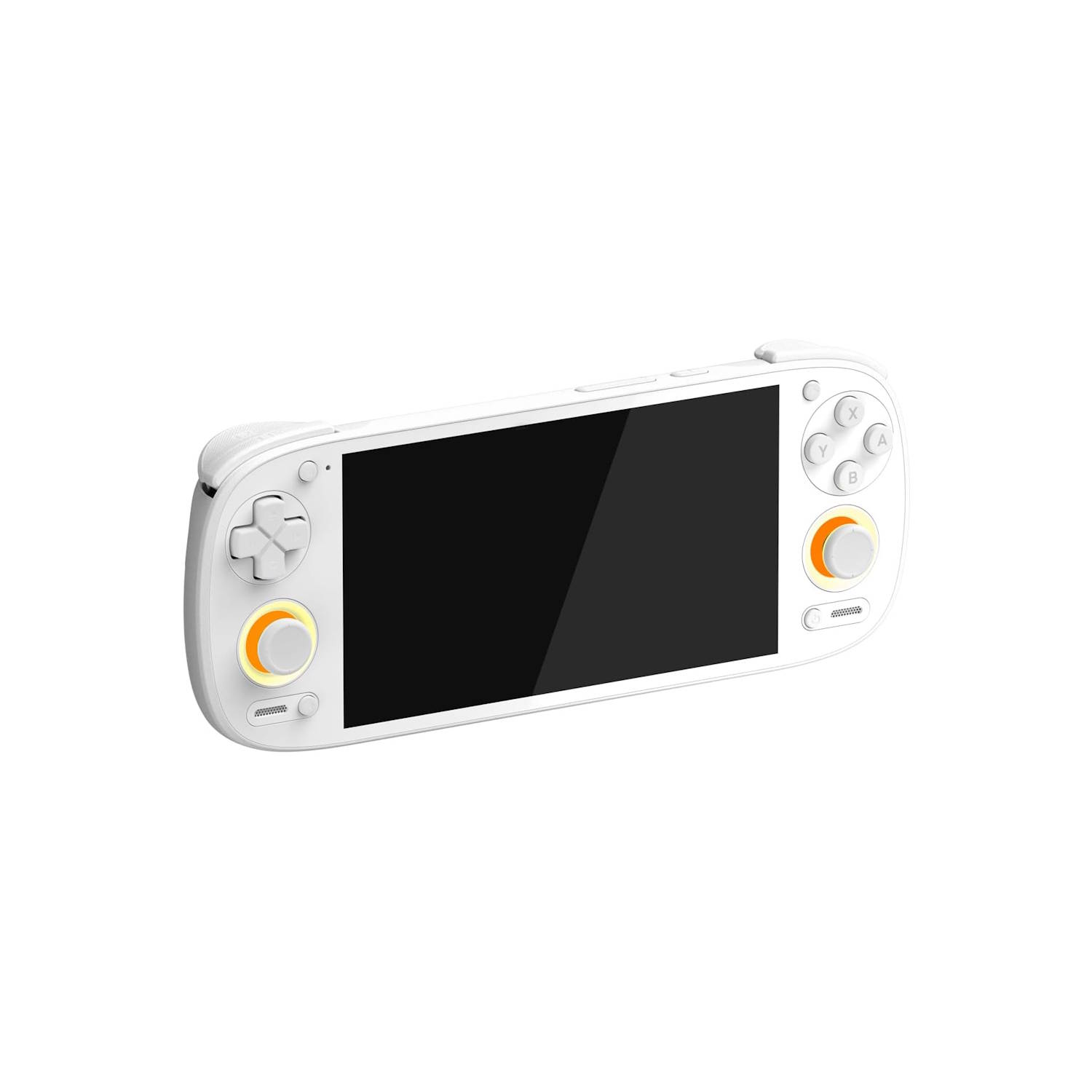

Retroid Pocket 5
Beautiful display • Solid emulation performance • Excellent battery life
MSRP: $259.00
The gold standard for Android retro gaming handhelds.
The Retroid Pocket 5 is the gold standard for Android gaming handhelds, with solid performance and a beautiful AMOLED screen.
Positives
Cons
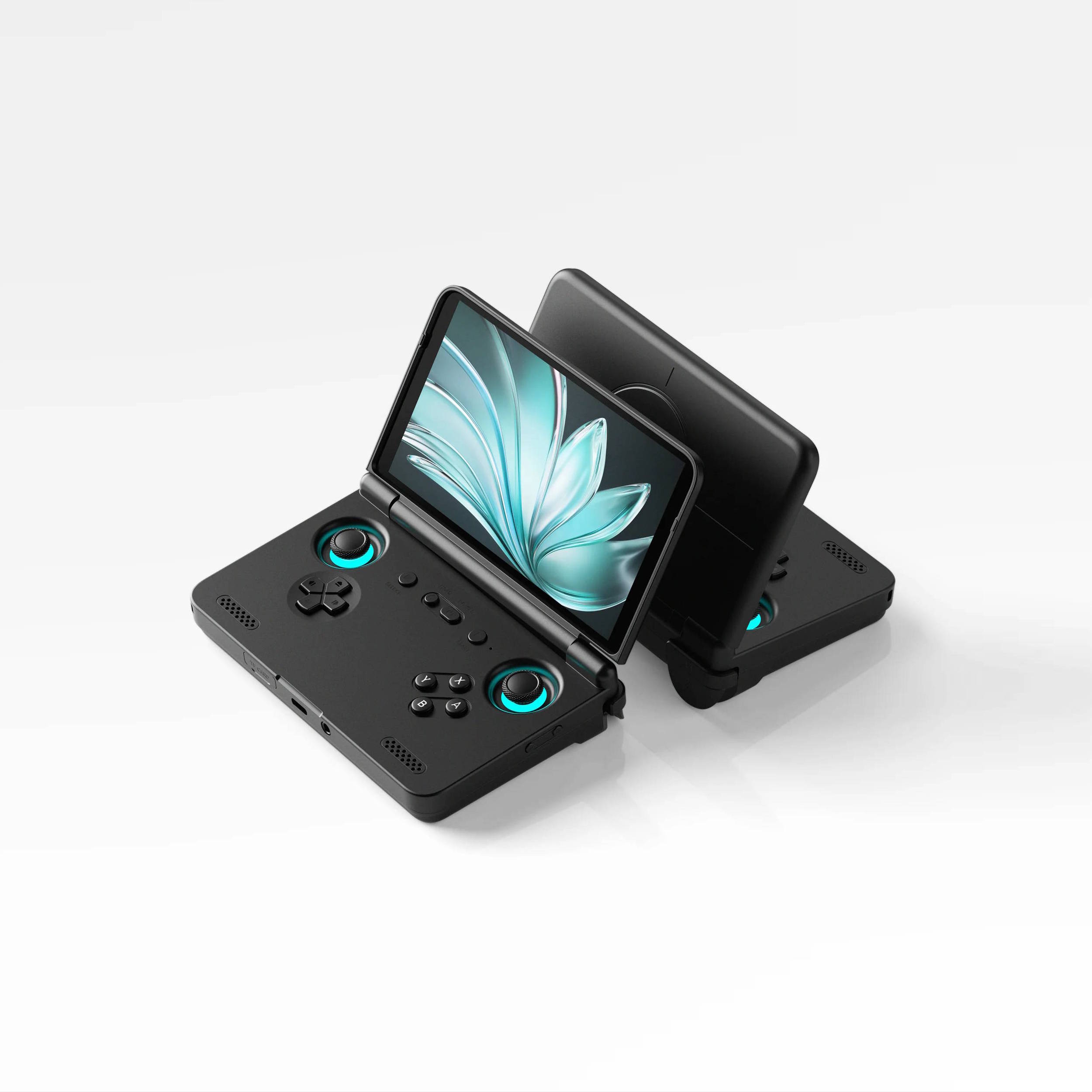

Retroid Pocket Flip 2
Beautiful display • Solid emulation performance • Nostalgic clamshell design
MSRP: $229.00
A nostalgic clamshell gaming handheld.
The Retroid Pocket Flip 2 is an exceptionally versatile device, with just enough performance for PS2, GameCube, and Dreamcast emulation.
Positives
Cons
Emulation on Android is often as much about drivers and community support as it is raw power, and the Retroid Pocket 5 and Pocket Flip 2 are two devices that perfectly demonstrate this. On the surface, the aging Snapdragon 865 SoC doesn’t look like much, but years of driver optimizations allow it to compete with much more powerful, and expensive, Android gaming handhelds.
Both of these handhelds share the same chipset, and they’re more than capable of emulating all of your favorite retro systems. More demanding tasks like Nintendo Switch, PS3, or Windows emulation will be hit-or-miss at best, but the dollar-for-dollar performance is still impressive if you just want to revisit the games from a bygone era.
Retroid's flagship handhelds offer incredible value for retro gamers.
The two handhelds also share the same beautiful 5.5-inch AMOLED screen, which is a clear highlight of the device. The main difference is the form-factor: one is a traditional horizontal handheld and the other is a clamshell. Personally, I prefer the portability of the Pocket Flip 2, but the Pocket 5 may be more comfortable to hold if you invest in a grip.
The Pocket 5 may also be a better pick if you want to emulate Nintendo DS or 3DS. Retroid’s Dual Screen Add-on clips onto the device to provide an immersive two-screen experience at the expense of battery life.
No matter which one you pick, the good news is that these handhelds are much easier to buy than most. While most are sold directly from China, these two are now available on Amazon. That means you can avoid any unexpected tariff or shipping charges, receive your device weeks faster, and enjoy faster and better customer service.

Nick Fernandez / Android Authority
Read more
AYANEO Pocket MICRO Classic: The best pocketable Android gaming handheld

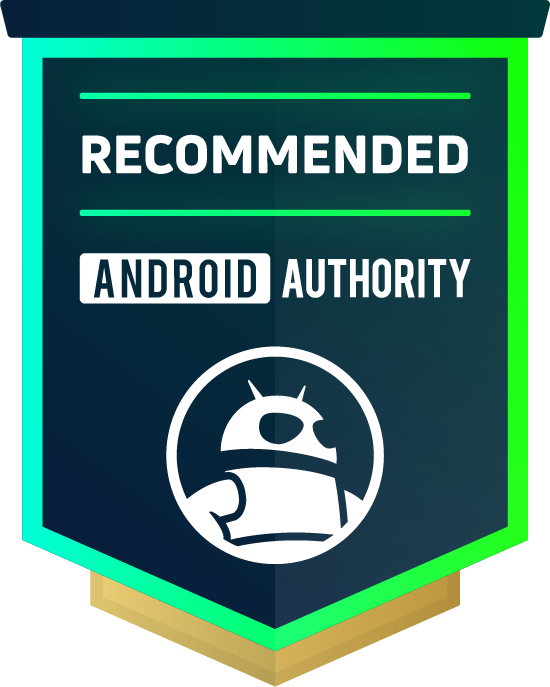
AYANEO Pocket Micro Classic
Beautiful retro design • Perfect 4x GBA scaling • Extra power for shaders
MSRP: $179.00
A modern Game Boy Micro.
The AYANEO Pocket Micro Classic is a GBA-focused handheld, powered by Android and inspired by the Game Boy Micro.
Positives
Cons
When it comes to Android gaming handhelds you can slip into a pocket, your options are surprisingly limited. Most are either too big or have pronounced sticks that make them difficult to pocket, but the AYANEO Pocket MICRO Classic is built different. This “Classic” revision of the Pocket MICRO removes the sticks, making it extra portable, and extra authentic.
Clearly inspired by the Game Boy Micro, the Pocket MICRO Classic is built first and foremost for GBA emulation. The screen offers pixel-perfect 4x upscaling of GBA games, but the 3:2 3.5-inch IPS panel is also great for playing retro games. The MediaTek Helio G99 isn’t the most powerful SoC on the block, but it’s more than enough to play your favorite retro games and enhance them with shaders.
But what really sets this handheld apart is the build quality. It has an excessively premium metal frame, with a seamless all-glass front. I can’t stress enough how good it feels to hold this thing in your hands, even when you’re not enjoying your favorite GBA games.
The Pocket MICRO Classic is excessively premium, and feels incredible to hold in your hands.
The only downside here is the price. The premium build demands a premium price, and you can find cheaper handhelds that offer the same level of emulation performance. However, none of them will slip as effortlessly into a pocket, and none of them spark the same amound of joy when you look at them.
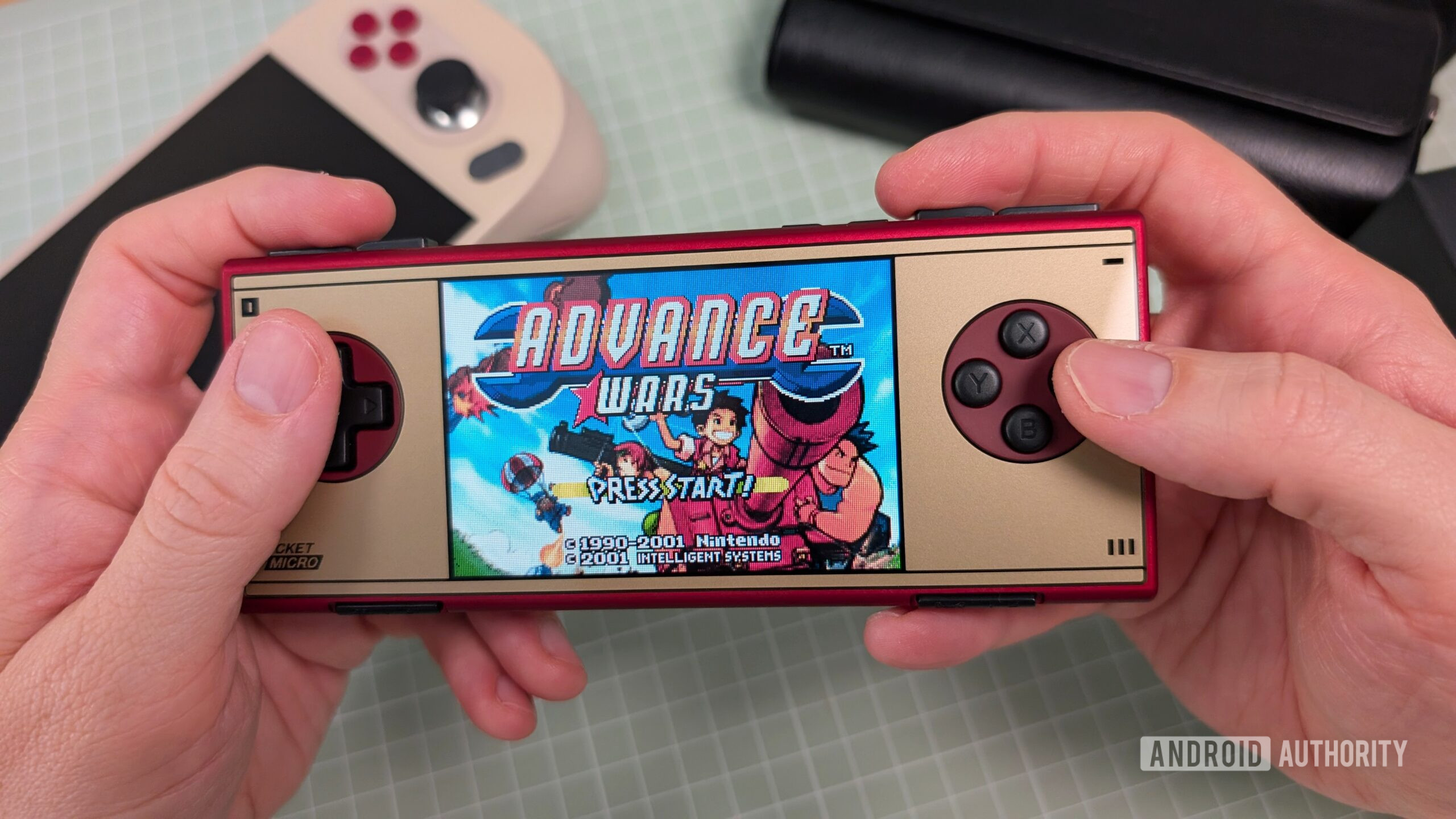
Nick Fernandez / Android Authority
Read more
AYANEO Pocket ACE: The best small Android gaming handheld


AYANEO Pocket ACE
Great performance • Small size • Premium build
MSRP: $459.00
The jack-of-all-trades emulation handheld
The AYANEO Pocket ACE is a small Android gaming handheld with enough power to emulate any system.
Positives
Cons
Small Android gaming handhelds have become increasingly popular, with options like the Retroid Pocket Mini V2 or AYN Odin 2 Mini shrinking down the hardware in their larger siblings for a more portable experience. But if there’s one small handheld that I’d recommend, it has to be the AYANEO Pocket ACE. I love this handheld, not only because it’s small, but also because it can emulate everything.
This tiny little guy is packing a Snapdragon G3X Gen 2, which is an overclocked 8 Gen 2 that’s designed for gaming handhelds. It flies through retro games with incredible efficiency, hitting nearly 15 hours of game time in retro systems. The 40W charging also tops it off in roughly 90 minutes, which is great for gaming on the go.
Of course, this chipset can also handle newer systems, including the Nintendo Switch. The 3:2 aspect ratio is only perfect for GBA games, but it also plays both 16:9 and 4:3 systems with minimal letterboxing. It’s not an OLED panel, but it has great colors and brightness.
If I had to choose one handheld for all my gaming needs, it would be the Pocket ACE.
That said, the sticks are very small and low on the device, so they’re not ideal for first-person shooters. It’s also expensive, but considering this device can cover all of my Android gaming handheld needs, it’s worth the premium.

Nick Fernandez / Android Authority
Read more
ANBERNIC RG 477M: The best Android gaming handheld for retro consoles
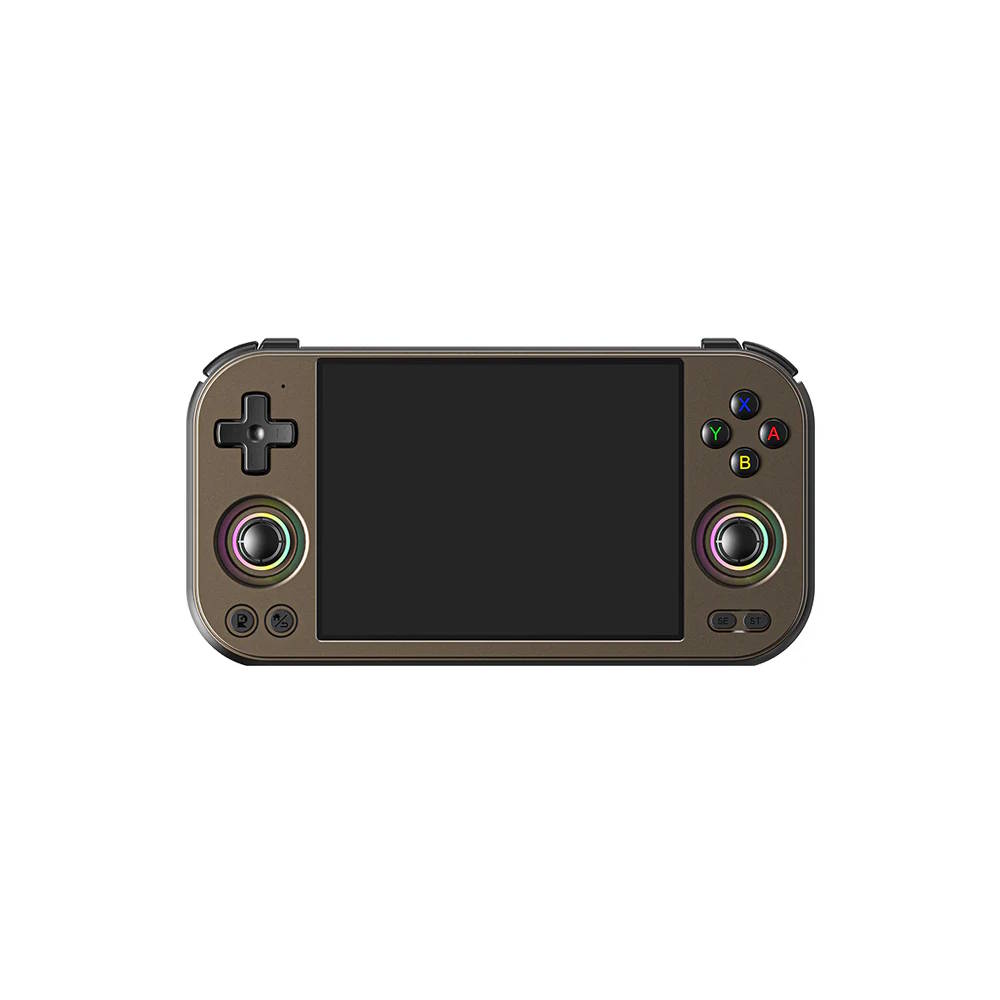

ANBERNIC RG 477M
Great performance • Incredible screen • Premium metal build
MSRP: $239.99
A powerful handheld with a retro aspect ratio
The RG 477M is a powerful handheld with a premium metal build and the perfect retro screen.
Positives
Cons
It’s easy to get caught up in adding more and more power, but sometimes it’s the simple things that really make a device. The ANBERNIC 477M is a great example here, with a 120Hz 4:3 display that’s absolutely perfect for retro consoles. In fact, once properly configured, it gets more than close enough to a classic CRT experience for my needs.
The key feature here is black frame insertion (BFI), which helps smooth out gameplay on high refresh rate devices. That, combined with the 4:3 aspect ratio and the right shaders, makes retro games really shine on this device.
Of course, BFI and shaders put an extra strain on the processor, which is where the extra power of the MediaTek Dimensity 8300 comes in. The Mali GPU might not have the same support for Switch or Windows emulation, but for everything up to and including PS2, it more than gets the job done.
With the right shaders and BFI, this screen really makes retro games pop.
It doesn’t really matter for performance, but the RG 477M also has a CNC metal shell that really gives it some heft. ANBERNIC does have cheaper devices with this screen, like the RG Slide or RG 476H, but only the RG 477M has enough power to make the most of it.

Nick Fernandez / Android Authority
Read more
AYANEO Pocket DMG: The best vertical Android gaming handheld


AYANEO Pocket DMG
Gorgeous OLED display • Classy retro design • Overkill performance
MSRP: $419.00
Overkill Android Game Boy!
The AYANEO Pocket DMG is a retro-tastic vertical Android handheld that looks like Nintendo's classic portable, but is packed with enough power to emulate demanding games and Android favorites.
Positives
Cons
When it comes to vertical handhelds, there’s one that clearly sits in a class of its own. The AYANEO Pocket DMG might look like a classic Game Boy, but it packs enough power to emulate everything up to and including the Nintendo Switch, provided you can deal with the unusual control scheme.
The Pocket DMG has a 3.92-inch AMOLED screen that’s miles better than what you’re probably used to from original hardware. Paired with the same Snapdragon Gx3 Gen 2 found on the Pocket ACE above, and you’re looking at one of the most powerful handhelds on the market, despite its form factor.
That said, the control scheme is designed with retro handheld games in mind. Sure, there’s a stick and a unique touchpad that we haven’t seen on any other Android handhelds to date, but anything that requires two sticks will require some workarounds.
The Pocket DMG is the ultimate Game Boy-style emulation handheld.
The other major downside to the Pocket DMG is its price. It’s one of the most expensive handhelds on our list, and its use case is more limited than most. Still, if you want the best, this is it.
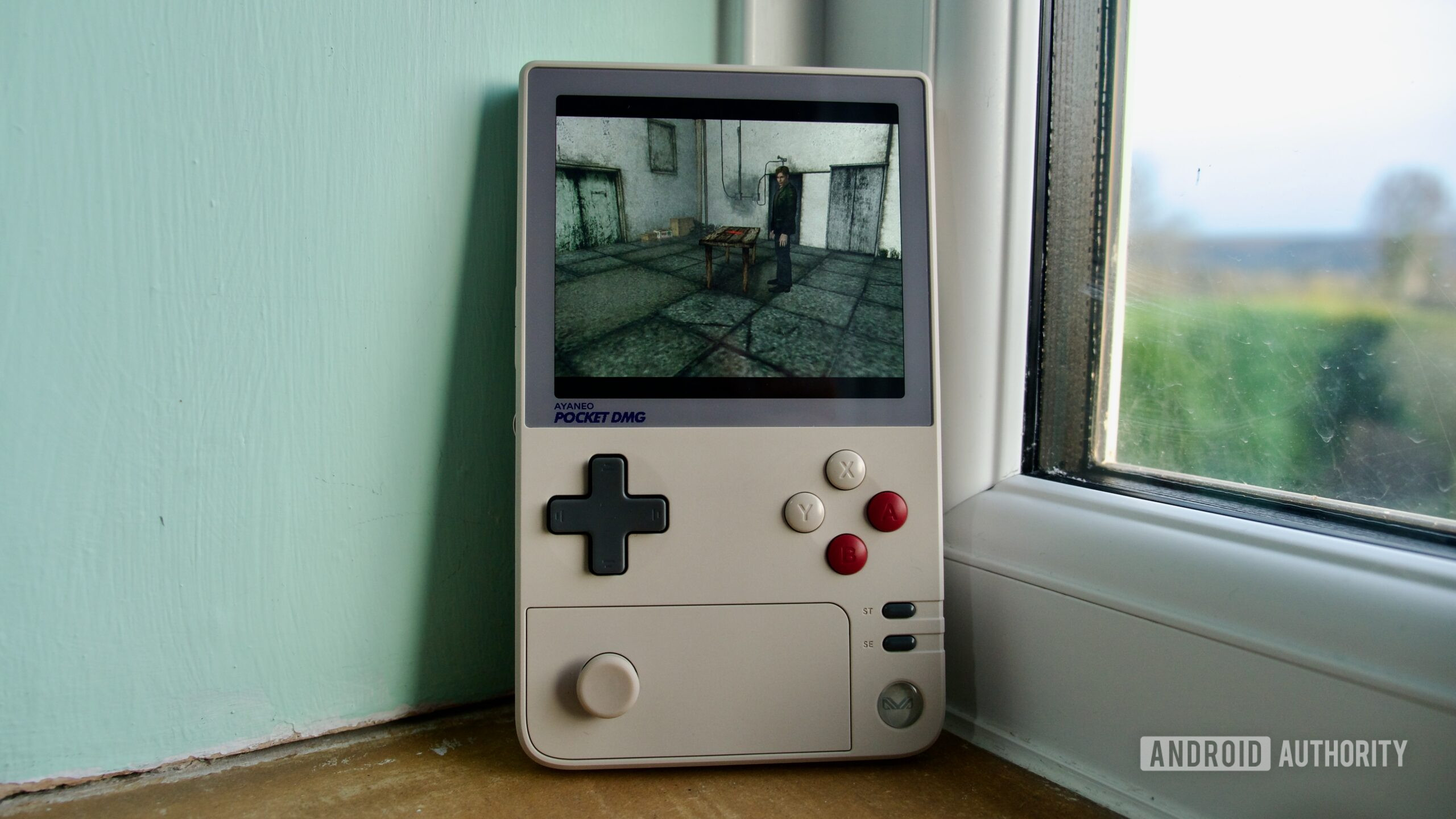
Oliver Cragg / Android Authority
Read more
Retroid Pocket Classic: Best Android gaming handheld under $150


Retroid Pocket Classic
Bright AMOLED display • Exceptional performance • Incredible value
MSRP: $119.99
A Game Boy for the modern (retro) gamer
The Retroid Pocket Classic offers exceptional retro gaming performance for the price, with a screen that can't be beat.
Positives
Cons
If you’re looking for an affordable Android retro gaming handheld, the Retroid Pocket Classic is my top pick. It has the same gorgeous AMOLED screen as the Pocket DMG above, but opts for a much more cost-effective processor to bring the total price well under $150.
This is the first and only handheld so far that uses the new Qualcomm Snapdragon G1 Gen 2 SoC, and it blew me away in my review. It punches so far above its price class that I’m surprised we haven’t seen more handhelds use it. Starting at $120, the Pocket Classic could easily emulate retro systems, including some PS2 titles if you can deal with frame dips.
It’s also worth mentioning that there are two different designs, one with four buttons and one with six. I tested the six-button variant, but the four-button version is probably more comfortable unless you’re particularly invested in early Sega systems.
The Pocket Classic punches well above its price class.
If you’re relatively new to retro gaming handhelds, the Pocket Classic can be a great introduction. At this price and level of performance, it’s a better buy than most Linux handhelds, and it has all of the added benefits of Android.

Nick Fernandez / Android Authority
Read more
Honorable mentions
AYANEO Pocket EVO
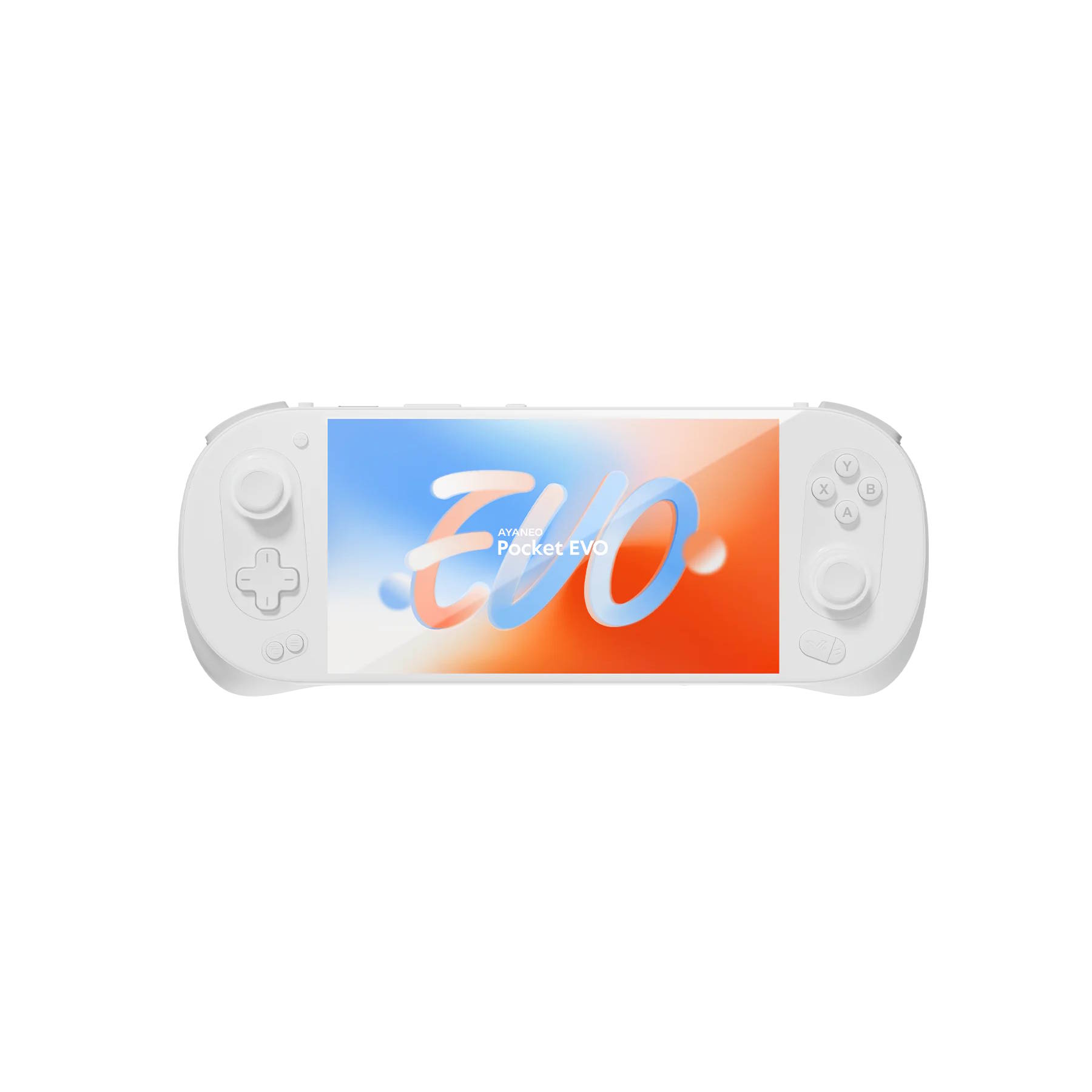

AYANEO Pocket EVO
Great performance • Large, beautiful screen • Perfect sticks and ergonomics
MSRP: $459.00
The Pocket EVO is powerful and comfortable, with incredible full-size sticks.
The AYANEO Pocket EVO is a boutique device done right. Its incredible screen, powerful handheld-first processor, and best-in-class sticks make it a compelling premium pick.
The AYANEO Pocket EVO is the most comfortable handheld I have ever used. The full-size sticks, massive 7-inch AMOLED screen, and powerful G3X Gen 2 SoC make it the ultimate Android gaming handheld, but the price makes it a tough sell for most buyers.
MagicX Zero 40
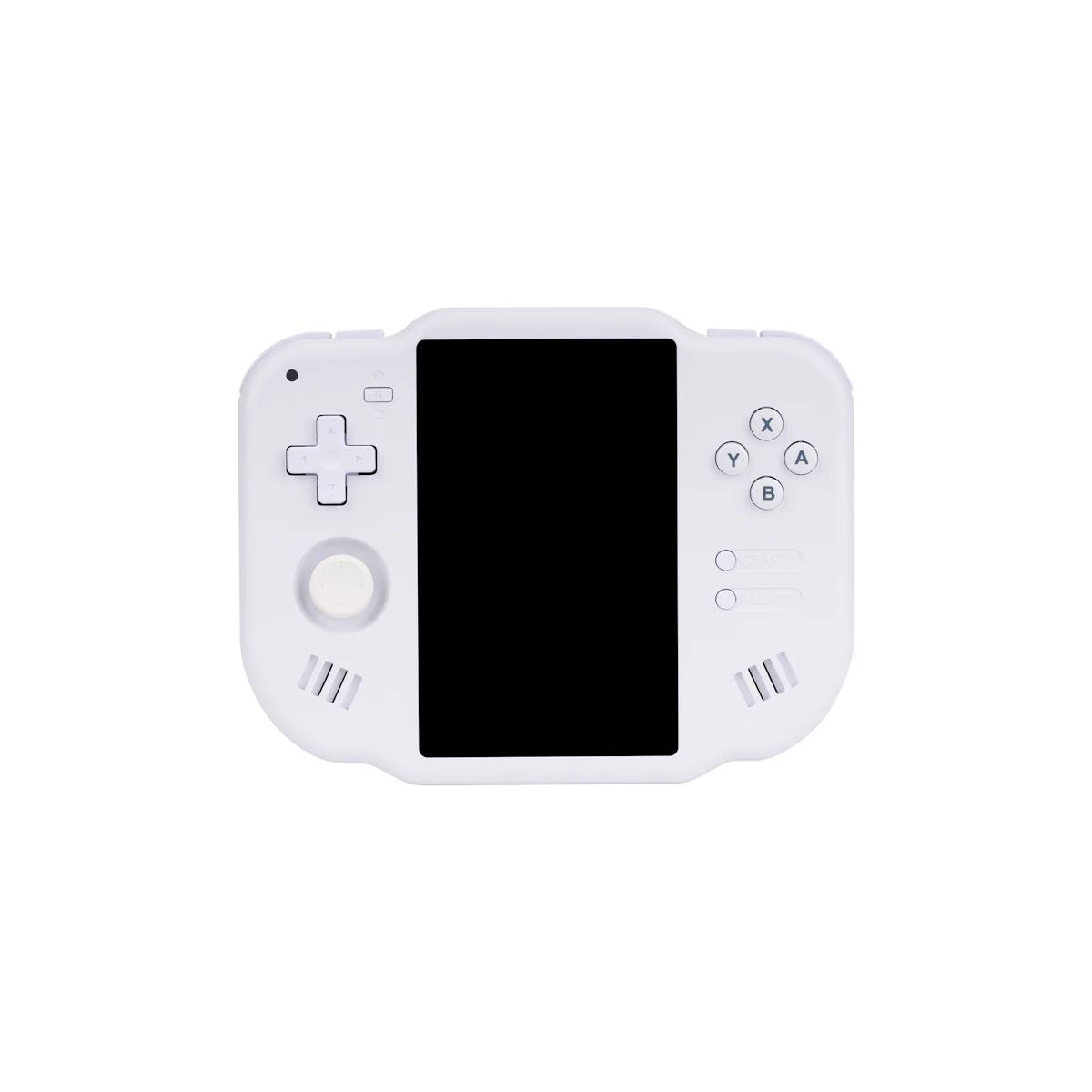
MagicX Zero 40
Killer DS emulation • Compact and comfortable • Plug-and-play
MSRP: $75.00
A Nintendo DS-focused gaming handheld
The MagicX Zero 40 turns an aging Android operating system into the best Nintendo DS emulation handheld on the market.
The Nintendo DS was an incredible console, and the MagicX Zero 40 is designed to emulate that console on a budget. It uses a tall vertical screen (which also makes it great for vertical arcade shooters) and a purpose-built launcher that feels much more like Linux than Android.
Retroid Pocket Mini
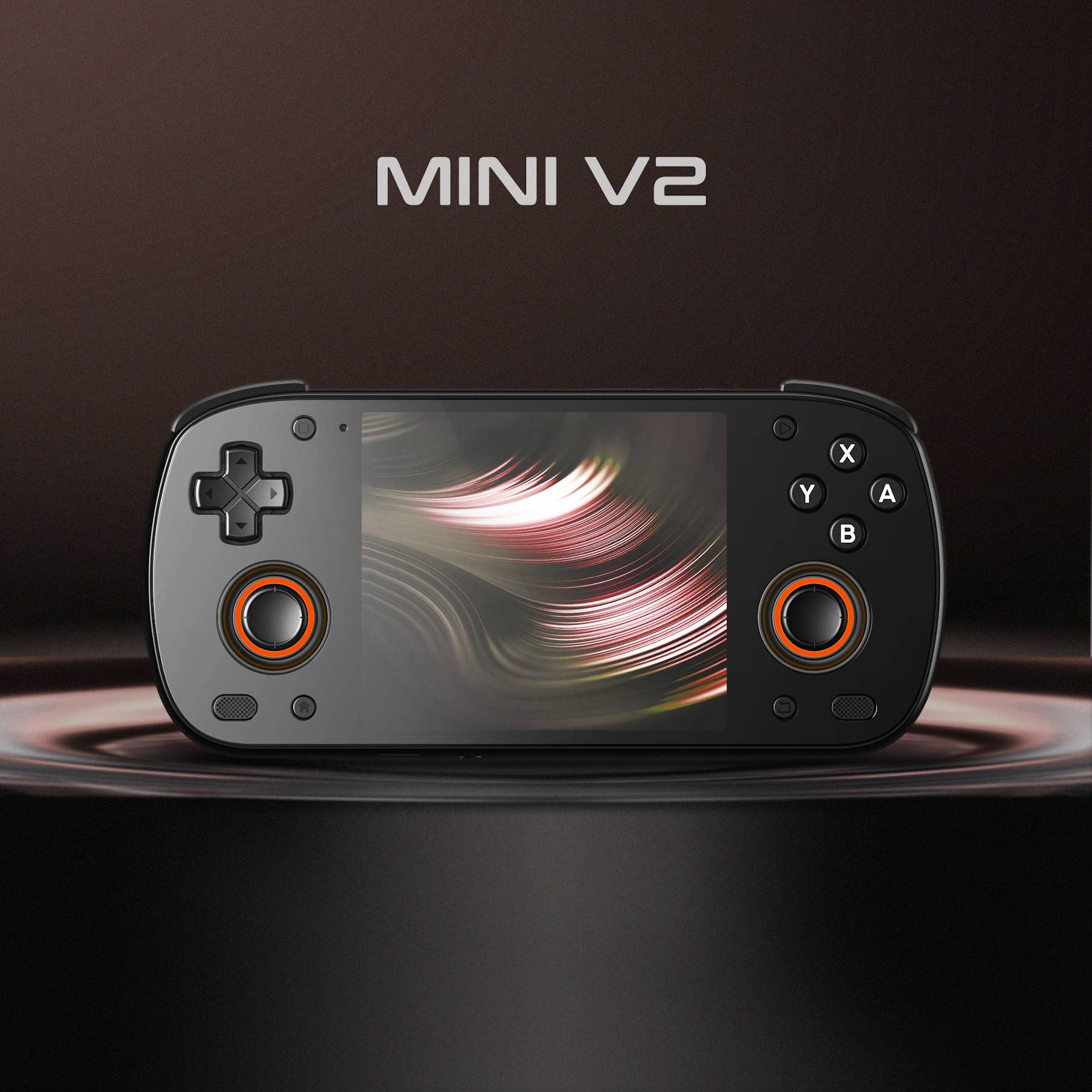
Retroid Pocket Mini
Very compact • Powerful for the size • OLED screen
MSRP: $199.00
A compact but powerful gaming handheld.
The Pocket Mini V2 packs a surprising amount of power into a compact device that's easy to take on the go.
Like phones, many Android gaming handhelds have gotten larger and larger over the years, but the Retroid Pocket Mini bucks that trend. The current version uses the same 3.92-inch AMOLED screen as the Pocket DMG and Pocket Classic above, but the Snapdragon 865 powering it provides a nice middle ground between the two in terms of performance.
ANBERNIC RG Slide


ANBERNIC RG Slide
Unique sliding design • Beautiful screen • Solid retro performance
MSRP: $189.99
A worthy spiritual successor to the Xperia Play.
A sliding gaming handheld like we haven't seen in decades.
Anyone who feels nostalgic about the PSP Go or Xperia Play should take a look at the ANBERNIC RG Slide. This is the first sliding handheld we’ve seen in over a decade, and it has the same beautiful retro-oriented 4:3 screen as the RG 477M.
What to look for in a good Android gaming handheld

Nick Fernandez / Android Authority
Android gaming handhelds are now available in all flavors, but there are a few simple things to consider when shopping for the right device for you. Obviously size and price are major considerations, but you also need to think about what you want to play. Are you looking to stick to retro systems, or do you want to test the frontier of Android emulation? Do you want to play twin-stick FPS games or slower strategy titles with the D-pad?
The perfect handheld has the right mix of build quality, power, and ergonomics.
There’s obviously a lot more to consider, so here’s a short list of things to look for:
Why you should trust me

Nick Fernandez / Android Authority
I grew up playing everything from the original Game Boy to the Nintendo DS and PSP, but I’ve been emulating games on Android for nearly a decade now. When Android-based gaming handhelds started growing in popularity, I tested the same emulators on devices designed first and foremost for gaming.
I’ve tested dozens of Android gaming handhelds in the past year alone, and I’m always getting the latest in for testing and review. I’ve also tested Windows and Linux handhelds, although Android remains my favorite platform for emulation-focused handhelds.
I have tested and reviewed more Android handhelds than I can count.
At the start of every review, I go through the full setup process as if it were my first handheld. Typically, that means using the default launcher and software, rather than jumping straight to custom configurations I’ve used in other devices.
Then, I run the device through our suite of benchmarks (based on how we typically test smartphones) to get an idea of what to expect in terms of performance. This provides objective performance data in a way that framerates on specific emulators don’t, since other factors like drivers, emulator updates, screen sizes, and more can lead to different results in gameplay.
What do you look for more than anything else in an Android gaming handheld?
17 votes
The right aspect ratio
12%
A nice OLED screen
12%
A powerful processor
29%
Perfect ergonomics
6%
Long battery life
6%
Software and ease of use
35%
Other
0%
Of course, the bulk of my Android gaming handheld testing involves playing games, including both native Android games and retro systems via emulation. This is where I get a feel for ergonomics, weight distribution, input quality, thermal performance, and much, much more.
Typically, my review period lasts one to two weeks, although I frequently return to past devices to test new updates or compare them with new releases. New drivers or firmware updates can have a huge effect on both compatibility and stability, which is essential if a handheld is to stand the test of time.
Thank you for being part of our community. Read our Comment Policy before posting.
Everything from the controls and screen to the chipset and proprietary software can make or break a gaming handheld. With that in mind, here are the Android gaming handhelds I would recommend for each use case.
AYN Odin 2 Portal: The best Android gaming handheld overall


AYN Odin 2 Portal
Incredible display • Superb performance • Lightweight
MSRP: $329.00
The ultimate Android gaming handheld.
The Odin 2 Portal has a massive OLED screen and enough power to make the most of it.
Positives
Incredible display
Superb performance
Lightweight
Great compatibility
Cons
Very large
Middling ergonomics
Pricey
For most people, the AYN Odin 2 Portal is the handheld to beat. Sure, it was released back in 2023, but the Snapdragon 8 Gen 2 is still an absolute powerhouse for emulation, and the 7-inch 120Hz AMOLED panel is still one of the best on the market.
No matter what you’re looking to play, the Odin 2 Portal can handle it with ease. Obviously that includes retro consoles, which look even better than the originals thanks to upscaling, shaders, and widescreen hacks. However, it can also handle the latest and greatest, including Nintendo Switch, PS3, and Windows emulation. The main limits there are software, not hardware.
That said, it is very large, and I wasn’t a fan of the ergonomics. I’d recommend picking up a simple grip to make it comfortable for longer gaming sessions, which the 8,000mAh battery is more than capable of powering through.
The Odin 2 Portal has a beautiful screen and enough power for demanding emulation.
I also have to mention that the Odin 3 is just around the corner, and it’s poised to revolutionize the Android gaming handheld space with a Snapdragon 8 Elite SoC. This is a massive leap forward in performance, but it will be at least six months to a year before driver support catches up. The Snapdragon 8 Gen 2 has some of the best driver support after years of Turnip driver improvements. You won’t see it on any spec sheets, but I cannot overstate just how important this is for emulation performance.

Nick Fernandez / Android Authority
Read more
Retroid Pocket 5/Flip 2: The best value Android gaming handheld


Retroid Pocket 5
Beautiful display • Solid emulation performance • Excellent battery life
MSRP: $259.00
The gold standard for Android retro gaming handhelds.
The Retroid Pocket 5 is the gold standard for Android gaming handhelds, with solid performance and a beautiful AMOLED screen.
Positives
Beautiful display
Solid emulation performance
Excellent battery life
Cons
Dated Snapdragon 865 SoC
Middling ergonomics without grip


Retroid Pocket Flip 2
Beautiful display • Solid emulation performance • Nostalgic clamshell design
MSRP: $229.00
A nostalgic clamshell gaming handheld.
The Retroid Pocket Flip 2 is an exceptionally versatile device, with just enough performance for PS2, GameCube, and Dreamcast emulation.
Positives
Beautiful display
Solid emulation performance
Nostalgic clamshell design
Excellent battery life
Cons
Cramped controls
Dated Snapdragon 865 SoC
Emulation on Android is often as much about drivers and community support as it is raw power, and the Retroid Pocket 5 and Pocket Flip 2 are two devices that perfectly demonstrate this. On the surface, the aging Snapdragon 865 SoC doesn’t look like much, but years of driver optimizations allow it to compete with much more powerful, and expensive, Android gaming handhelds.
Both of these handhelds share the same chipset, and they’re more than capable of emulating all of your favorite retro systems. More demanding tasks like Nintendo Switch, PS3, or Windows emulation will be hit-or-miss at best, but the dollar-for-dollar performance is still impressive if you just want to revisit the games from a bygone era.
Retroid's flagship handhelds offer incredible value for retro gamers.
The two handhelds also share the same beautiful 5.5-inch AMOLED screen, which is a clear highlight of the device. The main difference is the form-factor: one is a traditional horizontal handheld and the other is a clamshell. Personally, I prefer the portability of the Pocket Flip 2, but the Pocket 5 may be more comfortable to hold if you invest in a grip.
The Pocket 5 may also be a better pick if you want to emulate Nintendo DS or 3DS. Retroid’s Dual Screen Add-on clips onto the device to provide an immersive two-screen experience at the expense of battery life.
No matter which one you pick, the good news is that these handhelds are much easier to buy than most. While most are sold directly from China, these two are now available on Amazon. That means you can avoid any unexpected tariff or shipping charges, receive your device weeks faster, and enjoy faster and better customer service.

Nick Fernandez / Android Authority
Read more
AYANEO Pocket MICRO Classic: The best pocketable Android gaming handheld


AYANEO Pocket Micro Classic
Beautiful retro design • Perfect 4x GBA scaling • Extra power for shaders
MSRP: $179.00
A modern Game Boy Micro.
The AYANEO Pocket Micro Classic is a GBA-focused handheld, powered by Android and inspired by the Game Boy Micro.
Positives
Beautiful retro design
Perfect 4x GBA scaling
Extra power for shaders
Useful built-in software suite
Cons
Expensive
Not ideal for newer consoles
Middling battery life
When it comes to Android gaming handhelds you can slip into a pocket, your options are surprisingly limited. Most are either too big or have pronounced sticks that make them difficult to pocket, but the AYANEO Pocket MICRO Classic is built different. This “Classic” revision of the Pocket MICRO removes the sticks, making it extra portable, and extra authentic.
Clearly inspired by the Game Boy Micro, the Pocket MICRO Classic is built first and foremost for GBA emulation. The screen offers pixel-perfect 4x upscaling of GBA games, but the 3:2 3.5-inch IPS panel is also great for playing retro games. The MediaTek Helio G99 isn’t the most powerful SoC on the block, but it’s more than enough to play your favorite retro games and enhance them with shaders.
But what really sets this handheld apart is the build quality. It has an excessively premium metal frame, with a seamless all-glass front. I can’t stress enough how good it feels to hold this thing in your hands, even when you’re not enjoying your favorite GBA games.
The Pocket MICRO Classic is excessively premium, and feels incredible to hold in your hands.
The only downside here is the price. The premium build demands a premium price, and you can find cheaper handhelds that offer the same level of emulation performance. However, none of them will slip as effortlessly into a pocket, and none of them spark the same amound of joy when you look at them.

Nick Fernandez / Android Authority
Read more
AYANEO Pocket ACE: The best small Android gaming handheld


AYANEO Pocket ACE
Great performance • Small size • Premium build
MSRP: $459.00
The jack-of-all-trades emulation handheld
The AYANEO Pocket ACE is a small Android gaming handheld with enough power to emulate any system.
Positives
Great performance
Small size
Premium build
Complete controls
Cons
Expensive
IPS screen has minor light bleed
Small Android gaming handhelds have become increasingly popular, with options like the Retroid Pocket Mini V2 or AYN Odin 2 Mini shrinking down the hardware in their larger siblings for a more portable experience. But if there’s one small handheld that I’d recommend, it has to be the AYANEO Pocket ACE. I love this handheld, not only because it’s small, but also because it can emulate everything.
This tiny little guy is packing a Snapdragon G3X Gen 2, which is an overclocked 8 Gen 2 that’s designed for gaming handhelds. It flies through retro games with incredible efficiency, hitting nearly 15 hours of game time in retro systems. The 40W charging also tops it off in roughly 90 minutes, which is great for gaming on the go.
Of course, this chipset can also handle newer systems, including the Nintendo Switch. The 3:2 aspect ratio is only perfect for GBA games, but it also plays both 16:9 and 4:3 systems with minimal letterboxing. It’s not an OLED panel, but it has great colors and brightness.
If I had to choose one handheld for all my gaming needs, it would be the Pocket ACE.
That said, the sticks are very small and low on the device, so they’re not ideal for first-person shooters. It’s also expensive, but considering this device can cover all of my Android gaming handheld needs, it’s worth the premium.

Nick Fernandez / Android Authority
Read more
ANBERNIC RG 477M: The best Android gaming handheld for retro consoles


ANBERNIC RG 477M
Great performance • Incredible screen • Premium metal build
MSRP: $239.99
A powerful handheld with a retro aspect ratio
The RG 477M is a powerful handheld with a premium metal build and the perfect retro screen.
Positives
Great performance
Incredible screen
Premium metal build
Excellent D-pad and buttons
Cons
Limited driver compatibility
Loud shoulder buttons
Pricey
It’s easy to get caught up in adding more and more power, but sometimes it’s the simple things that really make a device. The ANBERNIC 477M is a great example here, with a 120Hz 4:3 display that’s absolutely perfect for retro consoles. In fact, once properly configured, it gets more than close enough to a classic CRT experience for my needs.
The key feature here is black frame insertion (BFI), which helps smooth out gameplay on high refresh rate devices. That, combined with the 4:3 aspect ratio and the right shaders, makes retro games really shine on this device.
Of course, BFI and shaders put an extra strain on the processor, which is where the extra power of the MediaTek Dimensity 8300 comes in. The Mali GPU might not have the same support for Switch or Windows emulation, but for everything up to and including PS2, it more than gets the job done.
With the right shaders and BFI, this screen really makes retro games pop.
It doesn’t really matter for performance, but the RG 477M also has a CNC metal shell that really gives it some heft. ANBERNIC does have cheaper devices with this screen, like the RG Slide or RG 476H, but only the RG 477M has enough power to make the most of it.

Nick Fernandez / Android Authority
Read more
AYANEO Pocket DMG: The best vertical Android gaming handheld


AYANEO Pocket DMG
Gorgeous OLED display • Classy retro design • Overkill performance
MSRP: $419.00
Overkill Android Game Boy!
The AYANEO Pocket DMG is a retro-tastic vertical Android handheld that looks like Nintendo's classic portable, but is packed with enough power to emulate demanding games and Android favorites.
Positives
Gorgeous OLED display
Rich emulation options
Classy retro design
Overkill performance
Solid battery life
Cons
Trackpad no good for 3D cameras
Awkward joystick placement
8:7 screen not a great fit for late gen emulation
Very expensive
When it comes to vertical handhelds, there’s one that clearly sits in a class of its own. The AYANEO Pocket DMG might look like a classic Game Boy, but it packs enough power to emulate everything up to and including the Nintendo Switch, provided you can deal with the unusual control scheme.
The Pocket DMG has a 3.92-inch AMOLED screen that’s miles better than what you’re probably used to from original hardware. Paired with the same Snapdragon Gx3 Gen 2 found on the Pocket ACE above, and you’re looking at one of the most powerful handhelds on the market, despite its form factor.
That said, the control scheme is designed with retro handheld games in mind. Sure, there’s a stick and a unique touchpad that we haven’t seen on any other Android handhelds to date, but anything that requires two sticks will require some workarounds.
The Pocket DMG is the ultimate Game Boy-style emulation handheld.
The other major downside to the Pocket DMG is its price. It’s one of the most expensive handhelds on our list, and its use case is more limited than most. Still, if you want the best, this is it.

Oliver Cragg / Android Authority
Read more
Retroid Pocket Classic: Best Android gaming handheld under $150


Retroid Pocket Classic
Bright AMOLED display • Exceptional performance • Incredible value
MSRP: $119.99
A Game Boy for the modern (retro) gamer
The Retroid Pocket Classic offers exceptional retro gaming performance for the price, with a screen that can't be beat.
Positives
Bright AMOLED display
Exceptional performance
Six-button option
Great battery life
Incredible value
Cons
No video out
Middling buttons
Some compatibility issues
If you’re looking for an affordable Android retro gaming handheld, the Retroid Pocket Classic is my top pick. It has the same gorgeous AMOLED screen as the Pocket DMG above, but opts for a much more cost-effective processor to bring the total price well under $150.
This is the first and only handheld so far that uses the new Qualcomm Snapdragon G1 Gen 2 SoC, and it blew me away in my review. It punches so far above its price class that I’m surprised we haven’t seen more handhelds use it. Starting at $120, the Pocket Classic could easily emulate retro systems, including some PS2 titles if you can deal with frame dips.
It’s also worth mentioning that there are two different designs, one with four buttons and one with six. I tested the six-button variant, but the four-button version is probably more comfortable unless you’re particularly invested in early Sega systems.
The Pocket Classic punches well above its price class.
If you’re relatively new to retro gaming handhelds, the Pocket Classic can be a great introduction. At this price and level of performance, it’s a better buy than most Linux handhelds, and it has all of the added benefits of Android.

Nick Fernandez / Android Authority
Read more
Honorable mentions
AYANEO Pocket EVO


AYANEO Pocket EVO
Great performance • Large, beautiful screen • Perfect sticks and ergonomics
MSRP: $459.00
The Pocket EVO is powerful and comfortable, with incredible full-size sticks.
The AYANEO Pocket EVO is a boutique device done right. Its incredible screen, powerful handheld-first processor, and best-in-class sticks make it a compelling premium pick.
The AYANEO Pocket EVO is the most comfortable handheld I have ever used. The full-size sticks, massive 7-inch AMOLED screen, and powerful G3X Gen 2 SoC make it the ultimate Android gaming handheld, but the price makes it a tough sell for most buyers.
MagicX Zero 40

MagicX Zero 40
Killer DS emulation • Compact and comfortable • Plug-and-play
MSRP: $75.00
A Nintendo DS-focused gaming handheld
The MagicX Zero 40 turns an aging Android operating system into the best Nintendo DS emulation handheld on the market.
The Nintendo DS was an incredible console, and the MagicX Zero 40 is designed to emulate that console on a budget. It uses a tall vertical screen (which also makes it great for vertical arcade shooters) and a purpose-built launcher that feels much more like Linux than Android.
Retroid Pocket Mini

Retroid Pocket Mini
Very compact • Powerful for the size • OLED screen
MSRP: $199.00
A compact but powerful gaming handheld.
The Pocket Mini V2 packs a surprising amount of power into a compact device that's easy to take on the go.
Like phones, many Android gaming handhelds have gotten larger and larger over the years, but the Retroid Pocket Mini bucks that trend. The current version uses the same 3.92-inch AMOLED screen as the Pocket DMG and Pocket Classic above, but the Snapdragon 865 powering it provides a nice middle ground between the two in terms of performance.
ANBERNIC RG Slide


ANBERNIC RG Slide
Unique sliding design • Beautiful screen • Solid retro performance
MSRP: $189.99
A worthy spiritual successor to the Xperia Play.
A sliding gaming handheld like we haven't seen in decades.
Anyone who feels nostalgic about the PSP Go or Xperia Play should take a look at the ANBERNIC RG Slide. This is the first sliding handheld we’ve seen in over a decade, and it has the same beautiful retro-oriented 4:3 screen as the RG 477M.
What to look for in a good Android gaming handheld

Nick Fernandez / Android Authority
Android gaming handhelds are now available in all flavors, but there are a few simple things to consider when shopping for the right device for you. Obviously size and price are major considerations, but you also need to think about what you want to play. Are you looking to stick to retro systems, or do you want to test the frontier of Android emulation? Do you want to play twin-stick FPS games or slower strategy titles with the D-pad?
The perfect handheld has the right mix of build quality, power, and ergonomics.
There’s obviously a lot more to consider, so here’s a short list of things to look for:
- Screen type: Beyond the simple size of the screen, you should also consider whether you want AMOLED or LCD. AMOLED has darker darks, but may trigger PWM sensitivity.
- Aspect ratio: Retro consoles use a wide variety of aspect ratios, so try to pick one that matches what you want to play. For example, 4:3 works well for retro home consoles, but 16:9 is the standard for PSP and Switch. Others, like 3:2, are only perfect for GBA, but offer minimal letterboxing for all other systems.
- Resolution and upscaling: Just like the aspect ratio, a screen’s resolution can have a big effect on upscaling, especially for games before the 3D era. Upscaling games via emulation can feel almost like a complete remaster, but if the pixels don’t match, things can look off in a way that’s difficult to pin down.
- Emulation power: While you can emulate most retro systems on weak devices, home consoles from the N64 era and up require a little extra oomph. Likewise with handhelds like the 3DS or PSP. And of course, if you want to emulate your Switch or Windows library, you’ll need all the power you can get.
- Software experience: There are plenty of emulation frontends that you can install on any Android gaming handheld, but most handhelds have a built-in frontend that works right out of the box. Apart from that, it can be useful to have overlays or performance toggles, which each OEM tends to handle differently.
- Build quality: Most Android gaming handhelds are made out of plastic, but there’s a big difference between premium and cheap plastics. On the premium end, you’ll also find metal builds and all-glass fronts. As for the internals, an easy test is to shake the handheld and listen for a rattle, which is a telltale sign of a cheap handheld.
- Ergonomics: Unlike a phone, gaming handhelds can offer great ergonomics for extended game time. This can be enhanced by first- or third-party grips, but be aware that this can add to the cost and prevent you from using official cases.
- Battery size and charging: Android gaming handhelds can be incredibly efficient when emulating retro games, and they offer great standby time when not in use. However, charging speeds on weaker handhelds can be painfully slow, so keep an eye on both the total capacity and the time it will take to top off if you want to keep gaming on the go.
Why you should trust me

Nick Fernandez / Android Authority
I grew up playing everything from the original Game Boy to the Nintendo DS and PSP, but I’ve been emulating games on Android for nearly a decade now. When Android-based gaming handhelds started growing in popularity, I tested the same emulators on devices designed first and foremost for gaming.
I’ve tested dozens of Android gaming handhelds in the past year alone, and I’m always getting the latest in for testing and review. I’ve also tested Windows and Linux handhelds, although Android remains my favorite platform for emulation-focused handhelds.
I have tested and reviewed more Android handhelds than I can count.
At the start of every review, I go through the full setup process as if it were my first handheld. Typically, that means using the default launcher and software, rather than jumping straight to custom configurations I’ve used in other devices.
Then, I run the device through our suite of benchmarks (based on how we typically test smartphones) to get an idea of what to expect in terms of performance. This provides objective performance data in a way that framerates on specific emulators don’t, since other factors like drivers, emulator updates, screen sizes, and more can lead to different results in gameplay.
What do you look for more than anything else in an Android gaming handheld?
17 votes
The right aspect ratio
12%
A nice OLED screen
12%
A powerful processor
29%
Perfect ergonomics
6%
Long battery life
6%
Software and ease of use
35%
Other
0%
Of course, the bulk of my Android gaming handheld testing involves playing games, including both native Android games and retro systems via emulation. This is where I get a feel for ergonomics, weight distribution, input quality, thermal performance, and much, much more.
Typically, my review period lasts one to two weeks, although I frequently return to past devices to test new updates or compare them with new releases. New drivers or firmware updates can have a huge effect on both compatibility and stability, which is essential if a handheld is to stand the test of time.
Thank you for being part of our community. Read our Comment Policy before posting.
